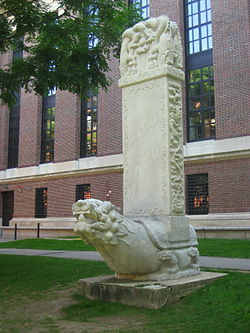- Harvard Bixi
-
Harvard's Chinese Stele
Harvard Bixi
Harvard Bixi with Widener Library in the backgroundLocation Cambridge, Massachusetts Type Chinese Stele Material Marble Height 17 feet Opening date 1796-1820[1] (construction date)
September 17, 1936 (presented to Harvard)Dedicated to Harvard University Coordinates 42°22′25″N 71°7′1″W / 42.37361°N 71.11694°WCoordinates: 42°22′25″N 71°7′1″W / 42.37361°N 71.11694°W The Harvard Bixi is a 17-foot high, 27 ton Chinese marble stele located at Harvard University, north of Boylston Hall and west of Widener Library in Harvard Yard, in Cambridge, Massachusetts. The stele was presented to the university by the Chinese Harvard Alumni for its Tercentenary in September 1936.[2]
Contents
History
The Bixi was created between 1796 and 1820 in Beijing, and the stele was originally a gift from the Jiaqing Emperor to a governor. Although the original inscription was unknown, the stele was kept in the Old Summer Palace.[1] However, the Old Summer Palace was mostly destroyed during the Second Opium War in 1860. It was uncertain whether the stele had remained in the ruin in Beijing between 1860 and 1936 when it was acquired by Chinese Harvard Alumni. The meticulous carvings of dragons chasing pearls on the sides and top of the marble tablet were the only traces that could indicate the stele’s imperial past.
Harvard's Tercentennial celebrations
In the 1930s there were five Harvard Clubs in China. More than 35 members of the clubs were known to be involved in donating the stele, and at least two of them attended the Tercentennial Ceremony in September 1936. They were Dr. J. Heng Liu, president of Harvard Club of Nanking,[3] and Fred Sze, a banker and the president of Harvard Club of Shanghai. New inscriptions were carved on the front of the marble tablet. Shih Hu, who was invited to take part in the Tercentennial Celebration to receive an honorary doctoral degree from Harvard, was believed to be among the calligraphers of the inscription.[4]
Inscription
The Bixi is inscribed with Chinese text[1] in which the content commemorates the tercentennial of Harvard University on behalf of Chinese Harvard Alumni. In September 1936[5] Dr. J. Heng Liu provided an English translation of the inscription which has been the official translation recorded in the Harvard Archives. However, it was unclear why the English translation provided by Dr. Liu did not contain a part in the inscription in which the Harvard Chinese alumni expressed hope for a brighter and more prosperous China.[6]
Following is part of the English translation provided by Dr. J. Heng Liu in 1936:[7]
The strength of a nation necessarily depends upon the progress of civilization, which in turn is contingent upon the growth of intellectual knowledge of its people. With this belief, many pioneers have devoted their lives to the promotion of education in all countries. Far-reaching effects in the enhancement of civilization are attained invariably although the results may not be apparent until hundreds of years have elapsed.
The truth of this statement is established by the celebration of this tercentennial of Harvard University. Imbued with the spirit of education, John Harvard left England over 300 years ago for the new colony in North America to become a teacher in Boston. Subsequently, he was instrumental in founding a college in Cambridge.
Today, as we celebrate the tercentennial of our alma mater, we look back with pride to the achievements of the founder and of other leaders who have followed in his steps. Their noble accomplishments are reflected in the world wide reputation of our alma mater as a seat of learning of the highest standards, in the wealth of valuable contribution, in the wide influence its children have exerted in many lands, and in the exalted position occupied by the nation in which it is situated.
Present
Due to acid rain and severe weathering, many of the inscriptions on the stele have become illegible. In the early 1980s the Fogg Museum Conservation Department examined the condition of the stele and proposed moving it to an indoor location. The site chosen was the Holyoke Center Arcade. Due to financial cost the plan was abandoned. In 1998 an informational notice appeared in front of the stele which stated the origin of the stele and that the University was working on a suitable indoor location for the statue. The notice did not offer a translation of the inscription.[8] Plans were also underway to relocate the stele to the Center for Government and International Studies (CGIS) buildings on Cambridge Street and Sumner Road. The CGIS was completed in 2005 but the stele remained in the Harvard Yard.
Various groups such as the Harvard Club of Beijing,[9] Harvard Club of Taipei and Harvard-Yenching Institute have expressed interests in preserving or restoring the stele since 2004. In 2009 the University Planning Office began to work on adding interpretive information to the base of the stele. A signage designer has been commissioned to study options for creating a sign at the base.
References
- ^ a b c Shand-Tucci, Douglass & Richard Cheek. Harvard University: an architectural tour. Princeton Architectural Press, 2001. p. 153.
- ^ The President and Fellows of Harvard College. The Tercentenary of Harvard College: A Chronicle of the Tercentenary Year 1935-1936. Harvard University Press, 1937. p. 138.
- ^ The Harvard Crimson. Harvard Club of Nanking Is Organized Overnight by Unanimous Vote at Dinner. February 19, 1936.
- ^ Macdonald, Vanessa Noëlle. Harvard’s Silent Dragon. A.M. thesis. Harvard University, 1999.
- ^ The Harvard Crimson. Weird Chinese Dragon In Yard Once Owned By Ch'ing Dynasty. September 12, 1944.
- ^ Macdonald, Vanessa Noëlle. Harvard’s Silent Dragon. A.M. thesis. Harvard University, 1999.
- ^ Harvard Tercentenary Bulletin. Harvard University Press, 1936.
- ^ Macdonald, Vanessa Noëlle. Harvard’s Silent Dragon. A.M. thesis. Harvard University, 1999.
- ^ Harvard Club of Beijing Announcement
Categories:- Chinese sculpture
- Harvard University
- Monuments and memorials in the United States
- Chinese steles
- Harvard Square
Wikimedia Foundation. 2010.


